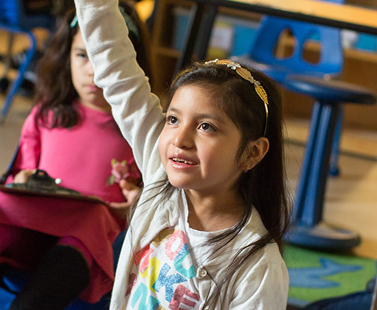4) How can I support my Multilingual Learners’ oral language development?
Oral language development—in both English and the home language—should be a central focus in teaching Multilingual Learners (MLs). Although not all programs provide intentional dual language instruction, research suggests that dual language education is optimal for young ML children’s learning and development26—this is the ideal goal for programs to reach. Oral language strategies should be used intentionally to promote both languages. Key oral language skills include expressive and receptive vocabulary, listening comprehension, and grammatical knowledge, all of which are critical for future reading comprehension.27 Teachers should incorporate rich and high-quality language experiences with back-and-forth exchanges in both languages, as consistent with the program’s language model. Such interactions foster language development and achievement.28
ML children’s developing language skills may also include code switching, or using words and phrases from both languages in a single sentence or exchange (check out the Toolkit on Code Switching from the Office of Head Start for more information). Such switching is a normal part of bilingual development and demonstrates children’s flexibility in drawing on the resources they have in both languages (read this Fact Sheet on Translanguaging for more information on how multilingual children use their full language repertoire to make sense of and communicate information). While MLs may have a smaller vocabulary in each language initially and lack some “translation equivalents,”29 educators should account for and encourage vocabulary use in both English and the home language. It is important for teachers to serve as strong language models in the languages that they speak. Further, they need to be clear about which language will be used at different times (language allocation).30 Teachers should also highlight the similarities and differences between the languages children speak and English in order to support children in making connections. By providing high-quality, culturally appropriate language interactions in both languages relevant to children’s experiences, educators help ML children develop a solid foundation in both of their languages, which will support future literacy and content learning.31
The following evidence-based strategies should be used with a specific purpose in mind, as consistent with the program’s language model, and differentiated and tailored to each individual child’s level and needs (which should be determined through continuous assessment). Oral language practices should be integrated with the other strategies presented in this Toolkit. For K–3 teachers, refer also to the California K–3 ELD Standards that highlight oral language interactions for MLs.
Sample Lesson Plan & Resource Walk
Access additional resources developed to introduce teachers to the work of supporting MLs’ oral language development. These activities, a sample lesson plan and a resource walk, are designed to support learning about this instructional topic area through structured exploration of resources on the website. Click the buttons below to access these resources.
Strategies in action



You can search across all strategies by keyword on our Research Search page. Give it a try!
Overarching Strategy: Provide language-rich environments to support each language.
Evidence-Based Strategies
4A) Provide high-quality, responsive, and extended talk in each language, including longer utterances with varied vocabulary, a mix of open-ended and scaffolding questions, providing child-friendly definitions for new or unfamiliar words, recasting or repeating an erroneous utterance in a corrected form, and engaging in back-and-forth exchanges.
TK
10-15 minutes
Downloadable template
Strategy Overview: Bounce Cards for Primary Grades (English)
5-10 minutes
Downloadable template
Strategy Overview: Bounce Cards for Primary Grades (Spanish and blank for other L1)
5-10 minutes
Video
Webinar: Promoting Oracy in Spanish Language / El desarollo de la oralidad en español (Spanish)
30-60 minutes
Video & Video Guide
Video & Video Guide: Adventures in Preschool Second Language Acquisition
TK
15-30 minutes
4B) Ask questions in each language, including a mix of open- and closed-ended questions, to elicit talk from children.
TK
10-15 minutes
TK
15-30 minutes
4C) Repeat and elaborate/expand on children’s talk in each language, for example, with adjectives, adverbs, or clauses that are related to the topic the child is discussing.
TK
10-15 minutes
TK
10-15 minutes
TK
15-30 minutes
TK
Under 5 minutes
Video & Video Guide
Video & Video Guide: Adventures in Preschool Second Language Acquisition
TK
15-30 minutes
4D) Incorporate songs, rhymes, and chants in each language, and connect them to content learning.
TK
Under 5 minutes
Video & Video Guide
Video & Video Guide: Adventures in Preschool Second Language Acquisition
TK
15-30 minutes
Overarching Strategy: Provide explicit vocabulary instruction in each language.
Evidence-Based Strategies
4E) Select commonly used academic words (e.g., observe, demonstrate, cycle, evaluate, conflict) and content-specific words or phrases (e.g., energy, habitat, food chain, law, freedom) from the focus of study and incorporate them in instruction.
TK
5-10 minutes
Downloadable template
Template: Personalized Oral Language Learning (POLL) Planning Grid
TK
Under 5 minutes
TK
10-15 minutes
5-10 minutes
10-15 minutes
10-15 minutes
4F) Explicitly teach words through multiple modalities of writing, speaking, and listening (e.g., vocabulary picture cards, word maps, visual aids, props, word walls, gestures, drawings).
TK
More than 60 minutes
5-10 minutes
10-15 minutes
Video
Webinar: Promoting Oracy in Spanish Language / El desarollo de la oralidad en español (Spanish)
30-60 minutes
4G) Reinforce target words by using them throughout the day and across contexts (e.g., present word during morning meeting, post on word wall, engage with associated objects and words during small group or free choice learning time).
TK
5-10 minutes
Downloadable template
Template: Personalized Oral Language Learning (POLL) Planning Grid
TK
Under 5 minutes
TK
5-10 minutes
4H) Provide hands-on, inquiry-based experiences (such as designing and carrying out experiments) to help give language meaning and purpose.
10-15 minutes
Strategies are interrelated
Individual strategies across the different instructional topics are interconnected and should be implemented together, in a purposeful and connected manner throughout instruction, and not in isolation. Make sure to also consider your classroom or school’s language model when implementing the strategies and adapt accordingly.
Visit how to use this site >

Alignment with Existing California Educator Guidance Documents & Resources
The Multilingual Learning strategies are closely aligned with existing guidance documents and resources for educators in California. Learn how Oral Language Development strategies align with these existing resources, or to see how the standards align across all strategies, visit the alignment reference guide page.


